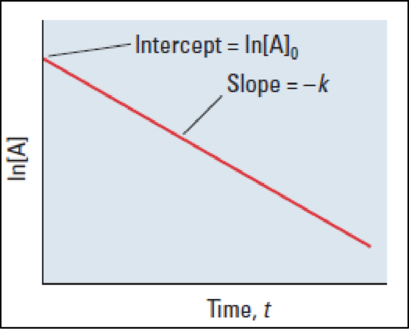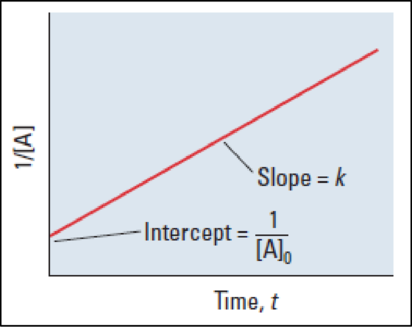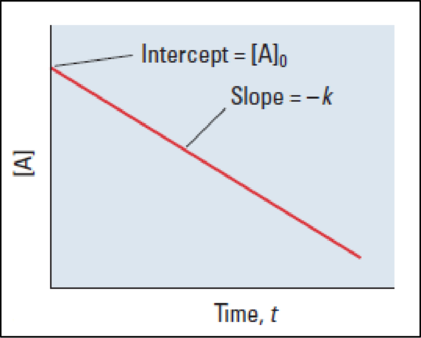
OWLV2 FOR MOORE/STANITSKI'S CHEMISTRY:
5th Edition
ISBN: 9781285460369
Author: STANITSKI
Publisher: Cengage Learning
expand_more
expand_more
format_list_bulleted
Question
Chapter 11.3, Problem 11.5PSP
Interpretation Introduction
Interpretation:
The order of the reaction with respect to
Concept Introduction:
First-order reaction plot:
The slope of the first-order plot gives the value of first order rate constant.

Figure 1
Second-order reaction plot:

Figure 2
Zero-order reaction plot:

Figure 3
Expert Solution & Answer
Want to see the full answer?
Check out a sample textbook solution
Students have asked these similar questions
Using the following two half-reactions, determine the pH range in which $NO_2^-\ (aq)$ cannot be found as the predominant chemical species in water.* $NO_3^-(aq)+10H^+(aq)+8e^-\rightarrow NH_4^+(aq)+3H_2O(l),\ pE^{\circ}=14.88$* $NO_2^-(aq)+8H^+(aq)+6e^-\rightarrow NH_4^+(aq)+2H_2O(l),\ pE^{\circ}=15.08$
Indicate characteristics of oxodec acid.
What is the final product when hexanedioic acid reacts with 1º PCl5 and 2º NH3.
Chapter 11 Solutions
OWLV2 FOR MOORE/STANITSKI'S CHEMISTRY:
Ch. 11.1 - For the reaction of crystal violet with NaOH(aq),...Ch. 11.1 - (a) From data in Table 11.1, calculate the rate of...Ch. 11.1 - For the reaction 4NO2(g)+O2(g)2N2O5(g) (a) express...Ch. 11.1 - Instantaneous rates for the reaction of hydroxide...Ch. 11.1 - Prob. 11.3CECh. 11.2 - Prob. 11.4ECh. 11.2 - Prob. 11.3PSPCh. 11.2 - Prob. 11.5ECh. 11.3 - Prob. 11.4PSPCh. 11.3 - Prob. 11.5PSP
Ch. 11.3 - Prob. 11.6PSPCh. 11.3 - Prob. 11.7PSPCh. 11.4 - Prob. 11.6ECh. 11.4 - Prob. 11.7CECh. 11.4 - Prob. 11.8PSPCh. 11.4 - Prob. 11.8CECh. 11.5 - Prob. 11.9PSPCh. 11.5 - The frequency factor A is 6.31 108 L mol1 s1 and...Ch. 11.6 - Prob. 11.10CECh. 11.7 - Prob. 11.11ECh. 11.7 - The Raschig reaction produces the industrially...Ch. 11.7 - Prob. 11.12ECh. 11.8 - The oxidation of thallium(I) ion by cerium(IV) ion...Ch. 11.9 - Prob. 11.11PSPCh. 11.9 - Prob. 11.14CECh. 11 - An excellent way to make highly pure nickel metal...Ch. 11 - Prob. 1QRTCh. 11 - Prob. 2QRTCh. 11 - Prob. 3QRTCh. 11 - Prob. 4QRTCh. 11 - Prob. 5QRTCh. 11 - Prob. 6QRTCh. 11 - Prob. 7QRTCh. 11 - Prob. 8QRTCh. 11 - Prob. 9QRTCh. 11 - Prob. 10QRTCh. 11 - Prob. 11QRTCh. 11 - Cyclobutane can decompose to form ethylene:
The...Ch. 11 - Prob. 13QRTCh. 11 - Prob. 14QRTCh. 11 - For the reaction 2NO2(g)2NO(g)+O2(g) make...Ch. 11 - Prob. 16QRTCh. 11 - Prob. 17QRTCh. 11 - Ammonia is produced by the reaction between...Ch. 11 - Prob. 19QRTCh. 11 - Prob. 20QRTCh. 11 - The reaction of CO(g) + NO2(g) is second-order in...Ch. 11 - Nitrosyl bromide, NOBr, is formed from NO and Br2....Ch. 11 - Prob. 23QRTCh. 11 - Prob. 24QRTCh. 11 - Prob. 25QRTCh. 11 - For the reaction
these data were obtained at 1100...Ch. 11 - Prob. 27QRTCh. 11 - Prob. 28QRTCh. 11 - Prob. 29QRTCh. 11 - Prob. 30QRTCh. 11 - Prob. 31QRTCh. 11 - Prob. 32QRTCh. 11 - For the reaction of phenyl acetate with water the...Ch. 11 - When phenacyl bromide and pyridine are both...Ch. 11 - The compound p-methoxybenzonitrile N-oxide, which...Ch. 11 - Prob. 36QRTCh. 11 - Radioactive gold-198 is used in the diagnosis of...Ch. 11 - Prob. 38QRTCh. 11 - Prob. 39QRTCh. 11 - Prob. 40QRTCh. 11 - Prob. 41QRTCh. 11 - Prob. 42QRTCh. 11 - Prob. 43QRTCh. 11 - Prob. 44QRTCh. 11 - Prob. 45QRTCh. 11 - Prob. 46QRTCh. 11 - Prob. 47QRTCh. 11 - Prob. 48QRTCh. 11 - Prob. 49QRTCh. 11 - Prob. 50QRTCh. 11 - Prob. 51QRTCh. 11 - Prob. 52QRTCh. 11 - For the reaction of iodine atoms with hydrogen...Ch. 11 - Prob. 54QRTCh. 11 - The activation energy Ea is 139.7 kJ mol1 for the...Ch. 11 - Prob. 56QRTCh. 11 - Prob. 57QRTCh. 11 - Prob. 58QRTCh. 11 - Prob. 59QRTCh. 11 - Prob. 60QRTCh. 11 - Prob. 61QRTCh. 11 - Prob. 62QRTCh. 11 - Prob. 63QRTCh. 11 - Which of the reactions in Question 62 would (a)...Ch. 11 - Prob. 65QRTCh. 11 - Prob. 66QRTCh. 11 - Prob. 67QRTCh. 11 - Prob. 68QRTCh. 11 - Prob. 69QRTCh. 11 - Prob. 70QRTCh. 11 - Prob. 71QRTCh. 11 - For the reaction the rate law is Rate=k[(CH3)3CBr]...Ch. 11 - Prob. 73QRTCh. 11 - Prob. 74QRTCh. 11 - Prob. 75QRTCh. 11 - For this reaction mechanism,
write the chemical...Ch. 11 - Prob. 77QRTCh. 11 - Prob. 78QRTCh. 11 - Prob. 79QRTCh. 11 - When enzymes are present at very low...Ch. 11 - Prob. 81QRTCh. 11 - The reaction is catalyzed by the enzyme succinate...Ch. 11 - Prob. 83QRTCh. 11 - Many biochemical reactions are catalyzed by acids....Ch. 11 - Prob. 85QRTCh. 11 - Prob. 86QRTCh. 11 - Prob. 87QRTCh. 11 - Prob. 88QRTCh. 11 - Prob. 89QRTCh. 11 - Prob. 90QRTCh. 11 - Prob. 91QRTCh. 11 - Prob. 92QRTCh. 11 - Prob. 93QRTCh. 11 - Prob. 94QRTCh. 11 - Nitryl fluoride is an explosive compound that can...Ch. 11 - Prob. 96QRTCh. 11 - Prob. 97QRTCh. 11 - For a reaction involving the decomposition of a...Ch. 11 - Prob. 99QRTCh. 11 - Prob. 100QRTCh. 11 - Prob. 101QRTCh. 11 - This graph shows the change in concentration as a...Ch. 11 - Prob. 103QRTCh. 11 - Prob. 104QRTCh. 11 - Prob. 105QRTCh. 11 - Prob. 106QRTCh. 11 - Prob. 107QRTCh. 11 - Prob. 108QRTCh. 11 - Prob. 109QRTCh. 11 - Prob. 110QRTCh. 11 - Prob. 111QRTCh. 11 - Prob. 112QRTCh. 11 - Prob. 113QRTCh. 11 - Prob. 114QRTCh. 11 - Prob. 115QRTCh. 11 - Prob. 116QRTCh. 11 - Prob. 118QRTCh. 11 - Prob. 119QRTCh. 11 - In a time-resolved picosecond spectroscopy...Ch. 11 - If you know some calculus, derive the integrated...Ch. 11 - If you know some calculus, derive the integrated...Ch. 11 - (Section 11-5) A rule of thumb is that for a...Ch. 11 - Prob. 11.BCPCh. 11 - Prob. 11.CCPCh. 11 - Prob. 11.DCP
Knowledge Booster
Learn more about
Need a deep-dive on the concept behind this application? Look no further. Learn more about this topic, chemistry and related others by exploring similar questions and additional content below.Similar questions
- What is the final product when D-galactose reacts with hydroxylamine?arrow_forwardIndicate the formula of the product obtained by reacting methyl 5-chloro-5-oxopentanoate with 1 mole of 4-penten-1-ylmagnesium bromide.arrow_forwardIn the two chair conformations of glucose, the most stable is the one with all the OH groups in the equatorial position. Is this correct?arrow_forward
- please help me with my homeworkarrow_forwardhelparrow_forwardThe temperature on a sample of pure X held at 1.25 atm and -54. °C is increased until the sample boils. The temperature is then held constant and the pressure is decreased by 0.42 atm. On the phase diagram below draw a path that shows this set of changes. pressure (atm) 2 0 0 200 400 temperature (K) Xarrow_forward
- QUESTION: Answer Question 5: 'Calculating standard error of regression' STEP 1 by filling in all the empty green boxes *The values are all provided in the photo attached*arrow_forwardpressure (atm) 3 The pressure on a sample of pure X held at 47. °C and 0.88 atm is increased until the sample condenses. The pressure is then held constant and the temperature is decreased by 82. °C. On the phase diagram below draw a path that shows this set of changes. 0 0 200 temperature (K) 400 аarrow_forwarder your payment details | bar xb Home | bartleby x + aleksogi/x/isl.exe/1o u-lgNskr7j8P3jH-1Qs_pBanHhviTCeeBZbufuBYT0Hz7m7D3ZcW81NC1d8Kzb4srFik1OUFhKMUXzhGpw7k1 O States of Matter Sketching a described thermodynamic change on a phase diagram 0/5 The pressure on a sample of pure X held at 47. °C and 0.88 atm is increased until the sample condenses. The pressure is then held constant and the temperature is decreased by 82. °C. On the phase diagram below draw a path that shows this set of changes. pressure (atm) 1 3- 0- 0 200 Explanation Check temperature (K) 400 X Q Search L G 2025 McGraw Hill LLC. All Rights Reserved Terms of Use Privacy Cearrow_forward
arrow_back_ios
SEE MORE QUESTIONS
arrow_forward_ios
Recommended textbooks for you
 Chemistry: The Molecular ScienceChemistryISBN:9781285199047Author:John W. Moore, Conrad L. StanitskiPublisher:Cengage Learning
Chemistry: The Molecular ScienceChemistryISBN:9781285199047Author:John W. Moore, Conrad L. StanitskiPublisher:Cengage Learning ChemistryChemistryISBN:9781305957404Author:Steven S. Zumdahl, Susan A. Zumdahl, Donald J. DeCostePublisher:Cengage Learning
ChemistryChemistryISBN:9781305957404Author:Steven S. Zumdahl, Susan A. Zumdahl, Donald J. DeCostePublisher:Cengage Learning Chemistry: An Atoms First ApproachChemistryISBN:9781305079243Author:Steven S. Zumdahl, Susan A. ZumdahlPublisher:Cengage Learning
Chemistry: An Atoms First ApproachChemistryISBN:9781305079243Author:Steven S. Zumdahl, Susan A. ZumdahlPublisher:Cengage Learning Chemistry: Matter and ChangeChemistryISBN:9780078746376Author:Dinah Zike, Laurel Dingrando, Nicholas Hainen, Cheryl WistromPublisher:Glencoe/McGraw-Hill School Pub Co
Chemistry: Matter and ChangeChemistryISBN:9780078746376Author:Dinah Zike, Laurel Dingrando, Nicholas Hainen, Cheryl WistromPublisher:Glencoe/McGraw-Hill School Pub Co Chemistry for Engineering StudentsChemistryISBN:9781337398909Author:Lawrence S. Brown, Tom HolmePublisher:Cengage Learning
Chemistry for Engineering StudentsChemistryISBN:9781337398909Author:Lawrence S. Brown, Tom HolmePublisher:Cengage Learning

Chemistry: The Molecular Science
Chemistry
ISBN:9781285199047
Author:John W. Moore, Conrad L. Stanitski
Publisher:Cengage Learning

Chemistry
Chemistry
ISBN:9781305957404
Author:Steven S. Zumdahl, Susan A. Zumdahl, Donald J. DeCoste
Publisher:Cengage Learning

Chemistry: An Atoms First Approach
Chemistry
ISBN:9781305079243
Author:Steven S. Zumdahl, Susan A. Zumdahl
Publisher:Cengage Learning


Chemistry: Matter and Change
Chemistry
ISBN:9780078746376
Author:Dinah Zike, Laurel Dingrando, Nicholas Hainen, Cheryl Wistrom
Publisher:Glencoe/McGraw-Hill School Pub Co

Chemistry for Engineering Students
Chemistry
ISBN:9781337398909
Author:Lawrence S. Brown, Tom Holme
Publisher:Cengage Learning
Kinetics: Initial Rates and Integrated Rate Laws; Author: Professor Dave Explains;https://www.youtube.com/watch?v=wYqQCojggyM;License: Standard YouTube License, CC-BY